Rubrica a cura di Susanna Schivardi e Massimo Casali
Che cosa rende unica un’azienda vinicola? I prodotti in primo luogo ma anche le personalità che dietro le bottiglie operano e pensano, cuore pulsante del successo. Ebbene, quest’oggi ci siamo nuovamente addentrati nei sentieri inattesi del Piemonte, regione ricca, controversa, piena di diversificazione viticola, dove già tempo fa avevamo avuto l’occasione di conoscere nomi del calibro di Germano e Armangia di Ignazio Giovine. Oggi non siamo tanto distanti da quelle realtà, la bellezza delle Langhe e soprattutto i vini che si producono hanno addomesticato i nostri sensi per sperimentare ancora una volta che la terra lì al Nord ha da offrire. Michael e Mara ci accolgono virtualmente in Canada, ebbene, collegati con un fuso di 5 ore che ci distanzia, hanno accettato di lasciarsi intervistare nonostante il loro italiano dignitoso ma stentato potrebbe risultare un ostacolo. Invece è solo un modo per renderci ancor più vicini, specialmente quando entrambi, in maniera alternata, iniziano a raccontare la loro storia.
Vinicola Arno è un nome che attraversa i secoli, perché Arno a differenza di quanto si potrebbe pensare, non c’entra nulla con la Toscana, ma risale all’epoca in cui i protestanti subirono le conseguenze della storia e molti si ritrovarono cacciati dalla terra di Francia verso le sponde inglesi, quindi la pronuncia esatta è Arnò, come ci spiega Michael, nato in Inghilterra ma da mamma emiliana, esattamente di Parma. E poi c’è Mara, la moglie che di emiliano o inglese non ha proprio nulla, anzi, lei vanta origini polacco-portoghesi e adozione brasiliana, esprime tutta la sua fragrante gioia tipicamente sudamericana narrando le gaie vicende che hanno portato lei e Michael ad incontrarsi proprio nel sud del Brasile, a Curitiba. Qui Mara lavorava per l’amministrazione comunale, e un giorno incontra Michael inviato come delegato per controllare che i suoi progetti fossero coerenti con le aspettative del governo. L’incontro, dopo un inizio ruvido, finisce con un bel matrimonio che sfocia in due bellissimi figli, oggi poco più che ventenni. Quanto a incontri avventurosi nemmeno la mamma di Michael si era fatta mancare nulla, fuggita dalla misera e poco promettente realtà parmense, era sbarcata in Inghilterra per salire la scala sociale da domestica a cuoca presso l’ambasciata israeliana, per poi conoscere William, futuro marito e padre di Michael.
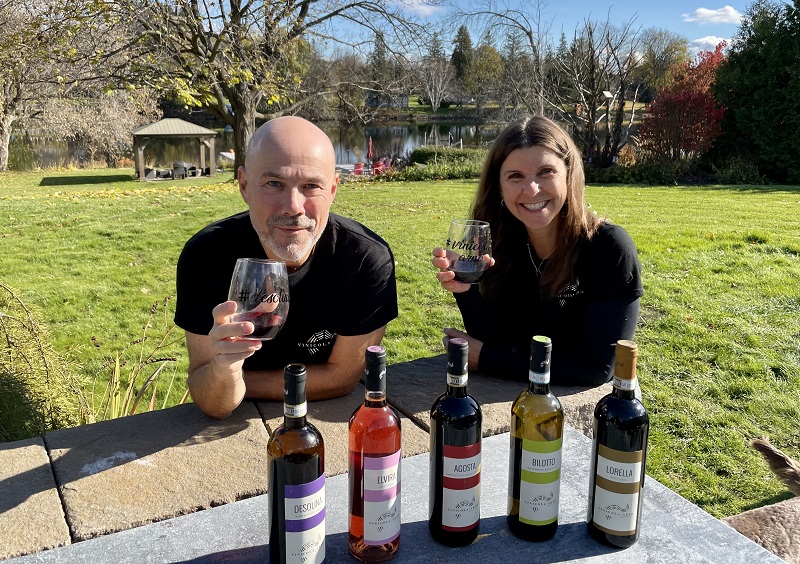
Da questo blend miracoloso di razze nasce Vinicola Arno, frutto anche della fervida immaginazione di una Mara che ferma non ci sa proprio stare. Nottate trascorse su Google hanno rianimato la sua passione ormai un po’ sfocata dopo che i figli grandi hanno preso le loro strade. E senza dire niente a Michael ha iniziato a favoleggiare l’idea di acquistare dei terreni vitati, dopo aver sentito che lo avevano fatto anche il Ministro delle Finanze canadese e Usain Bolt.
Mara si avventura alla scoperta del Piemonte per la bontà dei vini e la vicinanza con le origini del marito e suggerisce a Michael questa come la destinazione per il loro progetto di vita. In Piemonte trovano il giusto appezzamento, proprio alla fine del loro tour perlustrativo. Iniziali cinque ettari miracolosi di Nizza e Barbera che aspettavano soltanto di essere raccolti e trasformati in nettare.
Da qui a produrre vino il passo non è né breve né semplice, però si avvalgono niente di meno che della competenza pluriennale di Ignazio Giovine dell’azienda L’Armangia, raffinatissimo enologo che abbiamo avuto il piacere di intervistare qualche mese addietro. Insieme ad Ignazio anche l’agronomo Ivo Gallo e per il marketing Paola Baldi, oltre alle persone di fiducia che lavorano nei vigneti, uno di loro ghanese che ha iniziato a chiamarli mamma e dadda. E in cantina, Giovanni Grillo con parecchi anni di esperienza alle spalle.
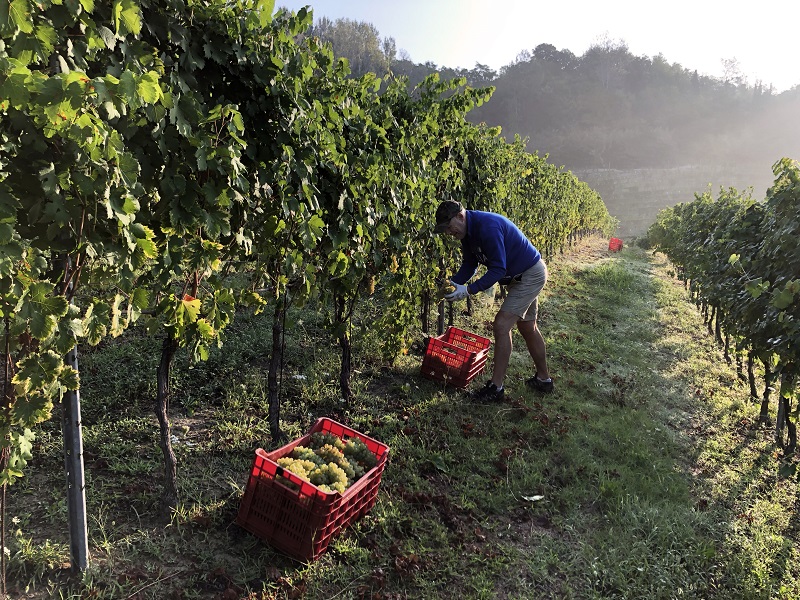
L’aria di grande mamy e grande daddy effettivamente gli appartiene, sono audaci, attenti, il mondo è nelle loro mani. Da poco collaborano con www.tannico.it la piattaforma online di vendita, ma il loro shop per adesso più cliccato è proprio sul sito, it.vinicolaarno.com dove arrivano ordini di Nascetta, Nizza e Barbera che giungeranno in quasi 18 paesi nel mondo.
Ogni bottiglia un nome e ogni nome lo stesso marchio, un’etichetta originale che rappresenta esattamente la forma dell’azienda ad anfiteatro, come sottolinea con immenso piacere Mara, che conosce questo pezzo di terra visto dall’alto, come le sue tasche.
Comunicativi ed espansivi non possono non accattivare qualsiasi cliente, in Canada hanno deciso di fare gli agenti di commercio dei loro stessi prodotti, in un paese dove il mercato riconoscono essere piuttosto chiuso. Sarà solo una questione di tempo, perché già adesso si meritano un bel premio Decanter 2020 per il Desolina, Decanter 2021 per il Desolina, Agosta e Lorella e i due bicchieri Gambero Rosso per il Lorella, in finale per i tre bicchieri. Ma andiamo a degustare quello che ci hanno inviato, cinque prodotti per una bella esperienza attraverso i vitigni più promettenti del Piemonte.
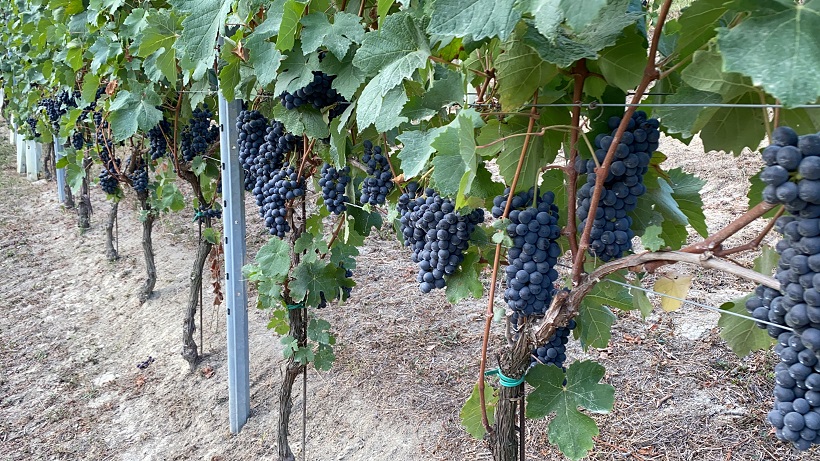
Michael e Mara ci seguono con la degustazione ed il primo vino che andiamo ad aprire è il Bilotto 2019 con un uvaggio di Nascetta per il 70% ed il restante Sauvignon. Michael ci racconta che ha deciso di inserire il sauvignon perché voleva più struttura ed acidità così, insieme a Ignazio Giovine, ha trovato la miscela giusta. Al naso molto intenso con molta mineralità e freschezza. Non mancano gli accenni morbidi con miele e frutta matura. In bocca molto intenso e corposo. La freschezza data dal sauvignon è ben presente e perfettamente equilibrata con la parte più fruttata. Presenti profumi balsamici di salvia ed eucalipto. Vino ottimo e persistente da abbinare ad un aperitivo ben consistente o a piatti di pesce elaborati. Lo vedo con un fungo porcino in carrozza con alici del Cantabrico o con San Pietro in padella con pomodori datterino e olive taggiasche. Il nome Bilotto una scorciatoia per il nome William che la zia di Michael non pronunciava volentieri.
Il secondo vino si chiama Elvira. Michael ha deciso di dedicarlo alla zia, una forza della natura che a 23 anni, rimasta vedova, ha costruito un piccolo impero a Parma. Ha iniziato a produrre questo vino con le uve barbera le stesse del Nizza. Lasciato sulle bucce per circa 4 ore questo vino ha un bel colore rosato intenso e, al momento della mescita nel bicchiere, si nota anche una leggera effervescenza. Subito profumi di fiori rossi ed una parte morbida di miele. Mineralità e balsamicità sempre presenti con una freschezza che fa salivare per qualche minuto. Lo abbinerei ad un aperitivo ma lo vedo molto bene con una degustazione di ostriche Prestige des Mers, Gillardeau e Belon.
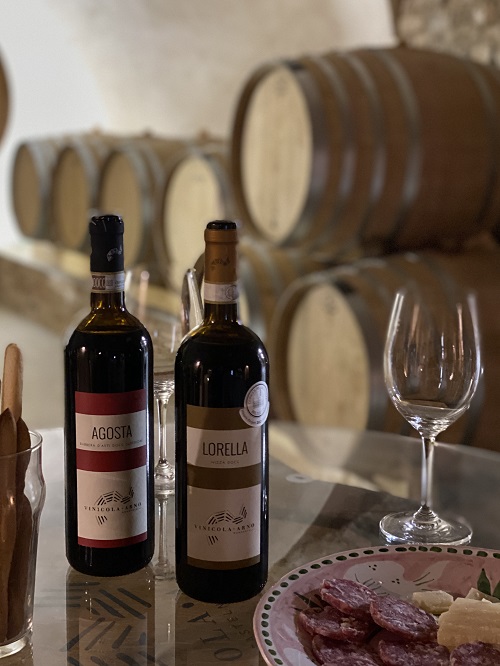
Ecco il momento dei rossi e cominciamo con Desolina Barbera d’Asti DOCG 2018. Stavolta la dedica alla mamma di Michael. Bel colore rosso porpora intenso con un’ottima consistenza. Profumo intenso con del sottobosco, frutta rossa, mora, prugna matura e fiori rossi. Presenti anche profumi leggeri di rosmarino ed erba appena tagliata. Una bella freschezza e mineralità. In bocca un vero bouquet di sapori. La frutta e la parte dolce sono perfettamente equilibrate con la freschezza. Vino corposo ed intenso. L‘astringenza, data dai tannini, si avverte qualche secondo dopo, rendendolo particolarmente persistente. Ci accorgiamo della presenza alcolica soltanto leggendo l’etichetta. 15 gradi alcolici perfettamente amalgamati a tutto il resto. Diciamo che se il vino base è questo negli altri ci aspetterà un vero divertimento. Vino non semplice ma di struttura, si può abbinare a piatti di carne piemontesi. Un buon bollito misto od anche ad un vitello tonnato.
Ora passiamo al vino Agosta Barbera D’Asti Superiore DOCG 2018. Dedicato ad Augusta, la mamma di Mara. Il nome modificato in Agosta perché sul mercato di Augusta già ce ne sono.
Colore rosso rubino. Al naso molto intenso con un’amarena ben presente. Ottima anche la balsamicità e il profumo di tabacco. Come nel precedente, i fiori rossi non mancano. Anche questo con 15 gradi alcolici perfettamente in sintonia con tutto il resto. La spalla acida accompagna tutta la parte morbida di frutta rossa. Una piccola percezione vanigliata rimane un po’ più a lungo ma sinceramente piacevole. I tannini ben presenti ci fanno presumere che questo vino tra qualche anno sarà al top del suo rendimento. Molto persistente anche questo vino, lo abbinerei a piatti importanti di carne. Scendendo verso il sud Italia lo potremmo abbinare ad una tartare di manzo toscana macinata a coltello con tuorlo di uovo crudo e cipolla tritata fine. Oppure ad una bella fiorentina dell’antica macelleria di Panzano in Chianti.
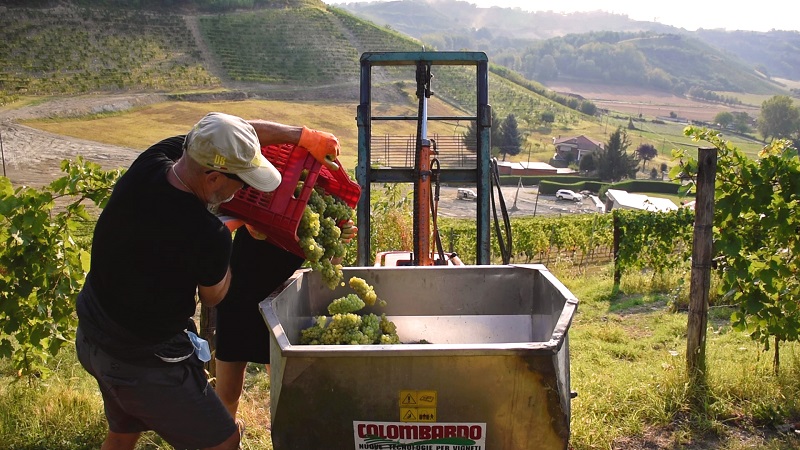
Ultimo vino che degustiamo è il Nizza DOCG 2018, il Lorella, nome nato dalla combinazione tra Lorenzo e Gabriella, i loro due fili.
Colore rosso rubino intenso, al naso una parte fruttata con amarena, prugna essiccata, mora, lampone e non mancano le percezioni balsamiche. Accenni di cacao amaro, caffè, pepe nero. In bocca il lampone dona parte della sua acidità, la frutta è presente. Come negli altri vini non percepiamo la parte alcolica che qui si attesta con i suoi 14,5 gradi alcolici. Vino importante e molto intenso. Tannini di grande qualità che rimangono vellutati e piacevoli. Da abbinare a piatti di carne importanti di tutta la penisola ma anche a dei marroni toscani magari davanti ad un bel camino ed in ottima compagnia. Micheal, Mara, Ivo ed Ignazio stanno facendo un lavoro meraviglioso e speriamo di incontrarli presto in attesa della riserva Leone, Nizza Riserva docg che sta maturando.
***Foto fornite dall’azienda
Intervista di Susanna Schivardi e degustazione a cura di Massimo Casali
https://www.facebook.com/sullastradadelvino.vino/
https://www.instagram.com/sullastradadelvino/
English version
Journey in Piedmont – discovering Vinicola Arno, a Nizza and Barbera winery in Monferrato Hills, founded by Mara and Michael Arno. A story from many years ago, due to the different family origins of the founders, who came back to the font where vineyards and wine are now successfully evolving and spreading all over the world
—an English version from the original one in Italian by Massimo Casali and Susanna Schivardi for the wine magazine online Sullastradadelvino
What makes a winery unique? The products, first and foremost, but also the personalities who work and think behind the bottles, the beating heart of success. Well, today we have once again entered the maze of Piedmont, a rich, controversial region, full of viticultural diversification, where already some time ago we had the opportunity to meet names of the caliber of Germano and L’Armangia from Ignazio Giovine.
Today we are not so far from those realities, the beauty of the Langhe and above all the wines that are produced there have tamed our senses to experience even more what the land there in the North has to offer. Michael and Mara virtually welcome us to Canada, well, connected with a 5-hour time zone that distances us, they agreed to let themselves be interviewed despite their dignified but stunted Italian that could prove to be an obstacle. Instead it is just a way to make us even closer, especially when both, alternately, begin to tell their story.
Vinicola Arno is a name that spans the centuries, because Arno, unlike what one might think, has nothing to do with Tuscany, but dates back to the time when the Protestants suffered the consequences of history and many found themselves driven from the earth from France to the English shores, so the exact pronunciation is Arnau, as Michael explains, born in England but to an Emilian mother, exactly from Parma. And then there is Mara, the wife who has nothing of Emilian or English at all, on the contrary, she of Polish-Portuguese origins and Brazilian adoption, expresses all her fragrant typically South American joy by narrating the gay events that led her and Michael to meet right in southern Brazil in Curitiba, where Mara worked for the municipal administration, and where one day she meets Michael sent there as a delegate to check that his projects were consistent with the government’s expectations. The meeting, after a rough start, ends with a beautiful marriage that leads to two beautiful children, now in their twenties. As for adventurous encounters, not even Michael’s mother missed anything, escaped from the miserable and unpromising Parma reality, she had landed in England to climb the social ladder from maid to cook for the Israeli embassy, to then meet William, future husband and Michael’s father.
Vinicola Arno is born from this miraculous blend of breeds, also the result of the fervid imagination of a Mara who just can’t stand still. Nights spent on Google have revived her passion by now a little fuzzy after her older children took their paths. And without saying anything to Michael, he began to talk about the idea of buying land under vines, after hearing that the Canadian Minister of Finance and Usain Bolt had also done so.
Mara ventured to discover Piedmont because of the excellence of its wines and the vicinity of her husband’s origins and suggested to Michael this as the destination for their life project. In Piedmont they found the right land, right at the end of their discovery tour. Initially five miraculous hectares of Nizza and Barbera just waiting to be harvested and transformed into nectar.
From here to producing wine the step is neither short nor simple, but they make use of nothing less than the long-term expertise of Ignazio Giovine of the L’Armangia company, a highly refined winemaker whom we had the pleasure of interviewing a few months ago. Together with Ignazio also the agronomist Ivo Gallo and Paola Baldi for marketing, as well as the trusted people who work in the vineyards, one of them from Ghana who has started to call them mama and dadda. And in the cellar, the very experienced Giovani Grillo.
The air of great mammy and great daddy actually belongs to them, they are bold, attentive, lively, the world is in their hands. They have recently started collaborating with www.tannico.it, the online sales platform WinePlatform, but for now their most clicked shop is on the site, it.vinicolaarno.com, where orders of Nascetta, Nizza and Barbera are arriving and will be sent to almost 18 countries around the world.
Every bottle has a name and every name has the same brand, an original label that exactly represents the shape of the amphitheatre-shaped winery, as Mara, who knows this piece of land as well as she knows its pockets, underlines with great pleasure.
Communicative and expansive, they can’t help but captivate any customer, and in Canada they have decided to act as sales agents for their own products, in a country where the market they acknowledge is rather closed. It will only be a matter of time, because they already deserve a nice Decanter 2020 award for the Desolina, and Decanter 2021 for the Desolina, Agosta and Lorella; and the two Gambero Rosso glasses for the Lorella, in the final for the three glasses. But let’s go and taste what they sent us, five products for a nice experience through the most promising vines of Piedmont.
Michael and Mara follow us with the tasting and the first wine we are going to open is Bilotto 2019 with a blend of 70% Nascetta and the remaining Sauvignon Blanc. Michael tells us he decided to add Sauvignon because he wanted more structure and acidity so, together with Giovine, he found the right blend. Very intense nose with lots of minerality and freshness. There is no lack of soft hints with honey and ripe fruit. In the mouth very intense and full bodied. The freshness given by sauvignon is well present and perfectly balanced with the fruity part. Balsamic aromas of sage and eucalyptus are present. An excellent and persistent wine to pair with a well-consistent aperitif or with elaborate fish dishes. I can see it with a porcini mushroom in carrozza with Cantabrian anchovies or with pan-seared San Pietro with datterino tomatoes and taggiasche olives. The name Bilotto is a shortcut for the name William, which Michael’s aunt did not like to pronounce.
The second wine is called Elvira. Micheal decided to dedicate it to his aunt, a force of nature who, at the age of 23, was widowed and built a small empire in Parma. They started producing this wine with Barbera grapes, the same used for Nizza. Left in skins for about 4 hours, this wine has a nice intense pink color and, at the moment of pouring it in the glass, a light effervescence is also noticed. Immediately smells of red flowers and a soft part of honey. Minerality and balsamicity always present with a freshness that makes you salivate for a few minutes. I would pair it with an aperitif but I see it very well with a tasting of Prestige des Mers, Gillardeau and Belon oysters.
Here is the time for reds and we start with Desolina Barbera d’Asti DOCG 2018. This time it is dedicated to Michael’s mother. Nice deep purple red color with excellent texture. Intense nose with some underbrush, red fruit, blackberry, ripe plum and red flowers. Also present are light scents of rosemary and freshly cut grass. Nice freshness and minerality. In the mouth a real bouquet of flavors. The fruit and sweet part are perfectly balanced with the freshness. Full bodied and intense wine. Astringency, given by tannins, is perceived a few seconds later, making it particularly persistent. We realize the presence of alcohol only by reading the label. 15% of alcohol by volume is perfectly amalgamated with everything else. Let’s say that if the base wine is this one, in the others it will be a real fun. Not a simple wine but with structure, it can be matched with Piedmontese meat dishes. A good mixed boiled meats or even vitello tonnato.
Now let’s move on to the Agosta Barbera D’Asti superiore DOCG 2018 wine. Dedicated to Augusta, Mara’s mother. The name changed to Agosta because there are already some on the Augusta market.
Ruby red color. Very intense nose with a well present black cherry. Excellent balsamicity and tobacco aroma as well. As in the previous one the red flowers are not missing. Also this with 15 degrees alcohol perfectly in tune with everything else. The acidic shoulder perfectly accompanies all the soft red fruit part. A little vanilla perception remains a bit longer but honestly very pleasing. The well present tannins make us assume that this wine will be at its best in a few years time. Very persistent as well, this wine I would pair with important succulent meat dishes. I would go down a little bit towards the south of Italy and pair it with a knife-ground Tuscan beef tartare with raw egg yolk and finely chopped onion. Or with a nice fiorentina from the old butcher shop in Panzano in Chianti.
The last wine in tasting experience is Nizza docg 2018.
Intense ruby red color, on the nose a fruity part with black cherry, dried plum, blackberry, raspberry not lacking balsamic perceptions. Hints of bitter cocoa, coffee, black pepper. In the mouth raspberry gives some of its acidity, the fruit is present. Just like in the other wines we do not perceive the alcoholic part which here is attested with 14.5% of alcohol by volume. An important and very intense wine. Tannins of great quality which remain velvety and pleasing. To be paired with important meat dishes from all over the peninsula but also with Tuscan marrons perhaps in front of a nice fireplace and in good company. Micheal, Mara and Ignazio have and are doing a wonderful job and we hope to meet them soon while waiting for the Leone, Nizza riserva docg that is maturing.
Thanks to Mara and Michael for the fitting translation of our original article about them on the following link https://www.gliscomunicati.it/2021/11/20/itinerari-piemontesi-sulla-strada-del-vino-incontra-michael-e-mara-dellazienda-vinicola-arno-in-piemonte-una-storia-di-famiglia-origini-e-intraprendenza/

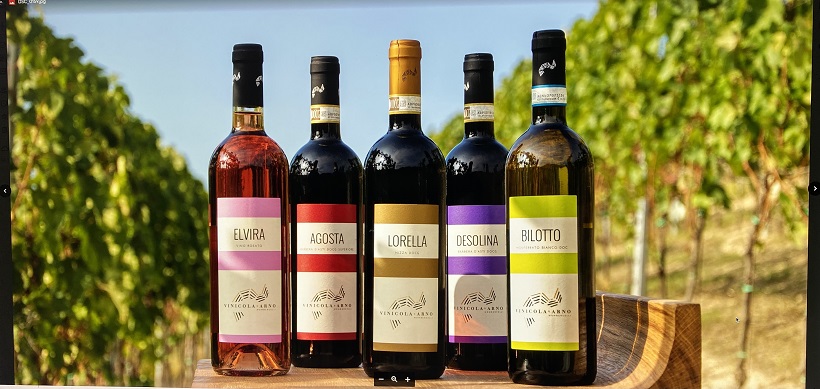
Lascia un commento